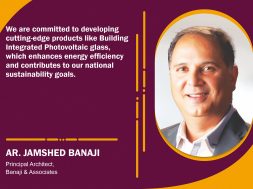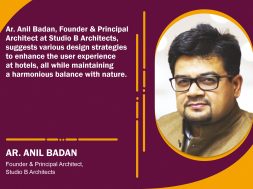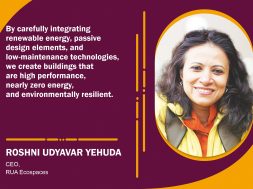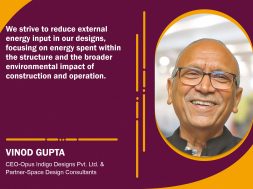Designs that make Indian cities smart
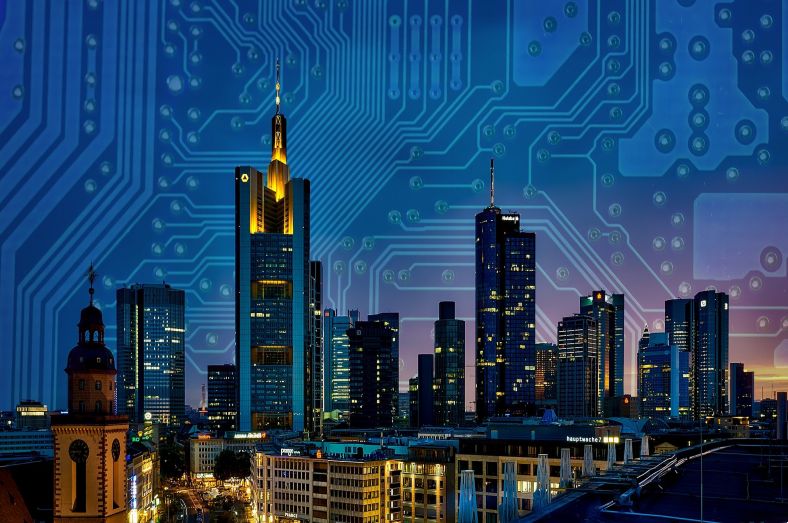
The leading experts across the architectural sector have shared their expertise in defining smart and affordable practices with energy efficiency for smart cities.
Smart cities focus on extending the life of natural resources, lowering operating expenses such as energy and water use, and ensuring human comfort, safety, and productivity. Other distinguishing characteristics include using non-toxic, recycled, and environmentally friendly building materials. For India to realise the ambitious infrastructure plan of smart cities, it would need safe design and intelligent materials and solutions that make the construction process quicker and faster. Smart materials and structures are among today’s most promising technologies for improving lifetime efficiency and dependability.
Cities can be considered condensed forms of human settlements and areas, locations where people choose to live well and access services. A smart city is sensitive to need,
problem-oriented, resilient, and sustainable from a larger viewpoint. While discussing the designs, Shailesh Pathak, Head of Urban Planning at Growever Infra Pvt Ltd, says, “The modern era is characterised by technology, which is constantly improving to enhance ease of living.” By utilising smart technologies and data analysis, a city can be made smart by optimising city operations, fostering economic development, and enhancing the quality of life for its residents. However, the result should be building relationships between the public and private sectors to create and maintain a data-driven environment, which may fall outside the purview of local government.
He adds, “The Government of India launched the Smart City Mission (SCM) with similar objectives in 2015. While self-reliant, the mission also supports various other schemes and programmes like AMRUT, PMAY, Digital India, etc.” Response The SCM prefers to respond to the needs of the hour, such as pollution, congested streets, and so on, through various programmes and awareness campaigns. Citizens applauded initiatives like “Street for People” and “Cycle for Change.”
Retrofit the SCM has assisted in the preservation and upkeep of historic structures and structures of public interest by promoting retrofitting and uplift. “The Regional Library in Warangal Smart City is an example of a quick yet viable solution. Also, the plan to renovate the renowned Local Ground in Kohima Smart City has been favourably embraced and praised.”
Reimagine while it’s crucial to take care of the city’s needs, it’s also necessary to reimagine the city and lift it to keep up with the times of expansion in technology and lifestyle. In one way or another, most smart cities have discovered a method to present a redesigned image of themselves. An excellent way to experience it is by looking at the Bhadrakali Lakefront Development in Warangal Smart City.
Smart cities and affordable practices
For a city to be smart, its resources must be used as efficiently as possible with the least amount of resource waste. Municipal services and utilities must be delivered effectively and efficiently. The programmes must be accessible and cheap. We must make an effort to examine diverse practices thoroughly and the potential for low-cost techniques for a smart city.
Anuprita Dixit, Design Director at IMK Architects, discusses affordable housing through citizen participation under the Smart City Mission in India. She states, “Almost half of Mumbai’s population lives in informal settlements and slums. With cramped houses, no natural light, ventilation, and open spaces, and inadequate access to clean water, healthcare, and education, living conditions in slums are extremely poor.” The current redevelopment scheme is developer-driven and profit-oriented. This has led to “vertical slums” in the city with similar challenges as those of a typical informal development—insufficient natural light and ventilation, limited open spaces, and
disproportionate courtyards. She also affirms, “Slums must be redeveloped to ensure affordability, inclusivity in decision-making, improved quality of life, and the socioeconomic well-being of the community. A community-led redevelopment process can help bridge the gap between developers and slum dwellers. At IMK Architects, we have worked on various self-redevelopment projects using this process to create better and more liveable homes for people.”
On discussing the cost-intensive solutions for sustainable designs, Anuprita says, “Capital costs for most sustainable measures are always high. Therefore, there is a need to strike a balance. Educating clients about the benefits of these measures is essential. We design within the context, based on the climate–temperature, rainfall and wind patterns, so achieving a sustainable solution without adding to the capital cost is possible. We can expect a better-built environment if these passive design strategies are integrated with other sustainable measures.” She adds, “Nowadays, with increasing awareness about sustainability, clients often come to us with a brief to design
a green building. Surprisingly, green certification is not their main goal. Today’s clients want to create an environment that focuses on users’ comfort. As far as the cost is
concerned, as mentioned earlier, several ways to achieve a sustainable design solution are not cost-intensive.”
Smart practises for energy efficiency
There are numerous opportunities to integrate energy efficiency through design and technology while building new facilities or during significant renovations of existing
ones. In the long run, using energy more effectively reduces costs and lessens the need to construct new polluting power plants.
Tripat Giridhar, Co-Founder of the Design Studio, takes this opportunity to elaborate on smart practices for energy efficiency. “The term “sustainability” for smart cities refers to using innovative design techniques to protect natural resources and lower energy costs. Due to population growth, many issues have arisen due to the demand for the existing infrastructure, energy needs, and availability of natural resources in the cities. Due to this, sustainability is required to address these problems.”
When a city adopts a sustainable design, it becomes intelligent. Hence, smart city activities ought to be intelligent as well. “Yet, the inventive sustainable design contributes to the reduction of carbon emissions, soil, groundwater, and noise pollution, as well as the enhancement of transportation systems, energy efficiency, and water efficiency.” Following all the practices to build a self-sufficient city will effectively and efficiently meet all of the requirements of its residents. The citizens will end up becoming better contributors to a prosperous society. Also, it helps in helping the city grow and develop efficiently.
108
Cookie Consent
We use cookies to personalize your experience. By continuing to visit this website you agree to our Terms & Conditions, Privacy Policy and Cookie Policy.






